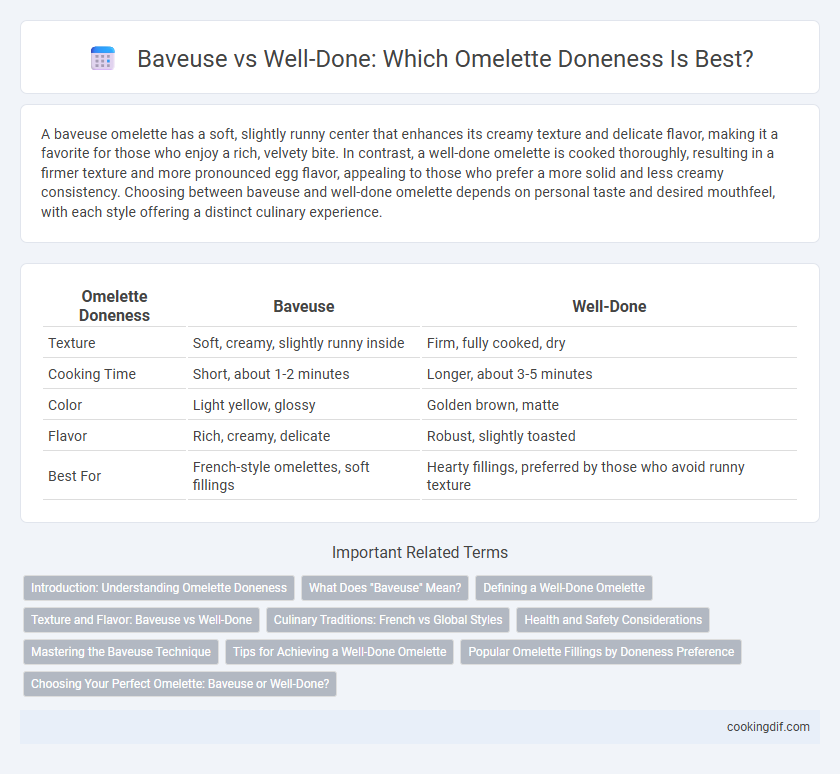A baveuse omelette has a soft, slightly runny center that enhances its creamy texture and delicate flavor, making it a favorite for those who enjoy a rich, velvety bite. In contrast, a well-done omelette is cooked thoroughly, resulting in a firmer texture and more pronounced egg flavor, appealing to those who prefer a more solid and less creamy consistency. Choosing between baveuse and well-done omelette depends on personal taste and desired mouthfeel, with each style offering a distinct culinary experience.
Table of Comparison
| Omelette Doneness | Baveuse | Well-Done |
|---|---|---|
| Texture | Soft, creamy, slightly runny inside | Firm, fully cooked, dry |
| Cooking Time | Short, about 1-2 minutes | Longer, about 3-5 minutes |
| Color | Light yellow, glossy | Golden brown, matte |
| Flavor | Rich, creamy, delicate | Robust, slightly toasted |
| Best For | French-style omelettes, soft fillings | Hearty fillings, preferred by those who avoid runny texture |
Introduction: Understanding Omelette Doneness
Omelette doneness is primarily categorized into Baveuse, which is creamy and slightly runny inside, and Well-Done, characterized by a fully set, firmer texture. Baveuse omelettes retain moisture and a rich, custard-like consistency, appealing to those who prefer a delicate mouthfeel. Well-Done omelettes offer a more structured bite, suited for fillings that benefit from a stable base and a less moist interior.
What Does "Baveuse" Mean?
Baveuse" describes an omelette with a slightly runny, creamy interior that remains soft and luscious, offering a delicate texture compared to a well-done omelette. This French term emphasizes a custard-like consistency where the eggs are gently cooked, preserving moisture and richness. In contrast, a well-done omelette is fully cooked through, firm, and dry, losing the characteristic silkiness associated with "baveuse".
Defining a Well-Done Omelette
A well-done omelette is characterized by a fully cooked interior with no visible runniness or moisture, resulting in a firm texture throughout. Unlike a baveuse omelette, which retains a slightly soft and creamy center, the well-done version emphasizes a consistent, dry surface and a golden-brown exterior from longer cooking. This level of doneness enhances the omelette's structural integrity, making it easier to fold and less prone to tearing.
Texture and Flavor: Baveuse vs Well-Done
A baveuse omelette features a creamy, slightly runny interior that offers a rich, velvety texture and a delicate, buttery flavor, enhancing the overall mouthfeel. In contrast, a well-done omelette has a firmer, fully cooked texture that provides a more robust and slightly caramelized taste due to the Maillard reaction. Texture and flavor preferences vary, with baveuse favored for smoothness and subtlety, while well-done appeals to those who enjoy a pronounced, slightly crispy character.
Culinary Traditions: French vs Global Styles
French culinary tradition favors the baveuse omelette, characterized by a creamy, slightly runny interior that highlights the delicate texture and rich flavor of eggs. In contrast, global styles often prefer well-done omelettes, fully cooked through for a firmer texture and ease of customization with diverse fillings. Understanding these differences underscores the cultural significance and varied preferences in omelette preparation worldwide.
Health and Safety Considerations
Baveuse omelettes, characterized by their slightly runny texture, may pose a higher risk of foodborne illness due to undercooked eggs, especially if raw eggs contain Salmonella bacteria. Well-done omelettes reach a safer internal temperature of 160degF (71degC), effectively eliminating most pathogens and reducing health risks. Choosing well-done omelettes ensures better food safety and is recommended for vulnerable groups, including pregnant women, young children, and immunocompromised individuals.
Mastering the Baveuse Technique
Mastering the baveuse technique in omelette preparation creates a soft, creamy texture that retains moisture and delicate flavor, contrasting with the firmer, drier well-done style. Baveuse omelettes require precise heat control and gentle folding to achieve the signature slightly runny interior without overcooking. This method enhances the richness of eggs, offering a gourmet experience favored by culinary professionals for its tender consistency and subtle taste.
Tips for Achieving a Well-Done Omelette
To achieve a well-done omelette, cook the eggs over medium heat, allowing the surface to set fully without browning. Use a non-stick skillet and add butter or oil to prevent sticking while cooking evenly. Fold the omelette carefully once the center is firm, ensuring a fully cooked texture without moisture inside.
Popular Omelette Fillings by Doneness Preference
Baveuse omelettes, known for their creamy, slightly runny interior, pair perfectly with delicate fillings like goat cheese, smoked salmon, and fresh herbs, enhancing their rich texture without overpowering. Well-done omelettes favor more robust fillings such as sauteed mushrooms, caramelized onions, and aged cheddar, which benefit from the firmer, fully cooked egg base to provide a hearty, satisfying bite. Popular omelette fillings are often chosen based on doneness preference to balance flavor intensity and mouthfeel, ensuring an optimal tasting experience.
Choosing Your Perfect Omelette: Baveuse or Well-Done?
Choosing your perfect omelette depends on texture preference: a baveuse omelette is slightly runny and soft, offering a creamy interior ideal for a delicate mouthfeel, while a well-done omelette is fully cooked through with a firm, fluffy texture. Baveuse omelettes retain more moisture and rich flavors, suited for those who favor a luscious, melt-in-the-mouth experience, whereas well-done omelettes provide a classic, hearty bite with a golden exterior. Mastering the cooking time and temperature is key to achieving the desired doneness and satisfying your specific taste.
Baveuse vs Well-Done for omelette doneness Infographic

 cookingdif.com
cookingdif.com